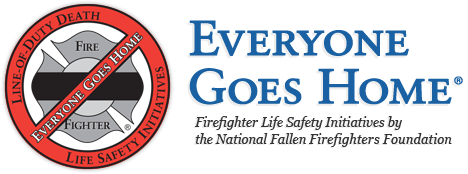More than 3,000 people die in home fires each year in the United States; most of whom are in homes without a working smoke alarm. To prevent these deaths, the U.S. Fire Administration (USFA), a division of the Federal Emergency Management Agency (FEMA) is sponsoring a nationwide Install. Inspect. Protect. Campaign designed to raise awareness about how working, properly installed smoke alarms can lower a person’s chances of dying in a fire. The National Fallen Firefighters Foundation and the Everyone Goes Home® Program are supporting this critical effort to reduce injuries and the loss of life.
The USFA’s Install. Inspect. Protect. Campaign is aimed at encouraging Americans to practice fire safety by installing and maintaining smoke alarms and residential fire sprinklers, which can help save the lives of residents and fire fighters, practicing fire escape plans, and performing a home safety walk-through to remove fire hazards from the home. The campaign is promoting fire safety through a free Campaign Toolkit disc; educational materials; print, radio and television PSAs; children’s materials, community organization-sponsored events and a consumer-friendly campaign website.
“The National Fallen Firefighters Foundation is proud to be a partner with the USFA in this very relevant campaign. Far too many people have died in fires as a result of not having working smoke alarms or sprinklers. One person killed in a home fire is just too many,” said Chief Ron Siarnicki, NFFF Executive Director. “Together, we can educate our communities and help save lives.”
“If a fire breaks out in your home while you’re asleep, how will you know? Having a working smoke alarm is like having a fire safety official on duty in your home, 24 hours a day.” said Deputy U.S. Fire Administrator Glenn A. Gaines. “Working smoke alarms will alert you to the fire and we know conclusively, a residential sprinkler system can help put the fire out.” Gaines adds, “Smoke alarms and sprinklers are able to provide residents the time it takes to get everyone out of the house, before firefighters have to come in.”
When both smoke alarms and fire sprinklers are present in a home, the risk of dying in a fire is reduced by 82 percent, when compared to a residence without either. According to the National Fire Protection Association, between 2003-2006, almost two-thirds of home fire deaths resulted from fires in homes with no smoke alarms or no working smoke alarms.
The USFA offers a few helpful tips on smoke alarms and sprinklers:
- Place properly installed and maintained smoke alarms both inside and outside of sleeping areas and on every level of your home.
- Interconnected smoke alarms are best, because if one sounds, they all sound.
- Get smoke alarms that can sound fast. The U.S. Fire Administration recommends that every residence and place where people sleep be equipped with both ionization and photoelectric smoke alarms or dual sensor smoke alarms, which contain both ionization and photoelectric smoke sensors.
- Inspect and test smoke alarms monthly and change alkaline batteries at least once every year, or as instructed. You can use a date you already know, like your birthday or when you change your clocks as a reminder.
- If possible, install residential fire sprinklers in your home.
- Avoid painting or covering the fire sprinkler, because that will affect the sensitivity to heat.
Organizations in partnership with the U.S. Fire Administration’s Install. Inspect. Protect. Campaign include the American Fire Sprinkler Association, Burn Institute, Everyone Goes Home, Fire and Emergency Manufacturers and Services Association, Fire Department Safety Officers Association, Home Fire Sprinkler Coalition, Home Safety Council, International Association of Black Professional Firefighters, International Association of Fire Chiefs, International Association of Women in Fire & Emergency Services, NASFM Fire Research and Education Foundation, National Association of Hispanic Firefighters, National Association of State Fire Marshals, National Fallen Firefighters Foundation, National Fire Protection Association, National Fire Sprinkler Association, National Volunteer Fire Council, and SAFE KIDS Worldwide.
For more information on the Install. Inspect. Protect. Campaign and other fire prevention information, please visit www.usfa.dhs.gov/smokealarms.



